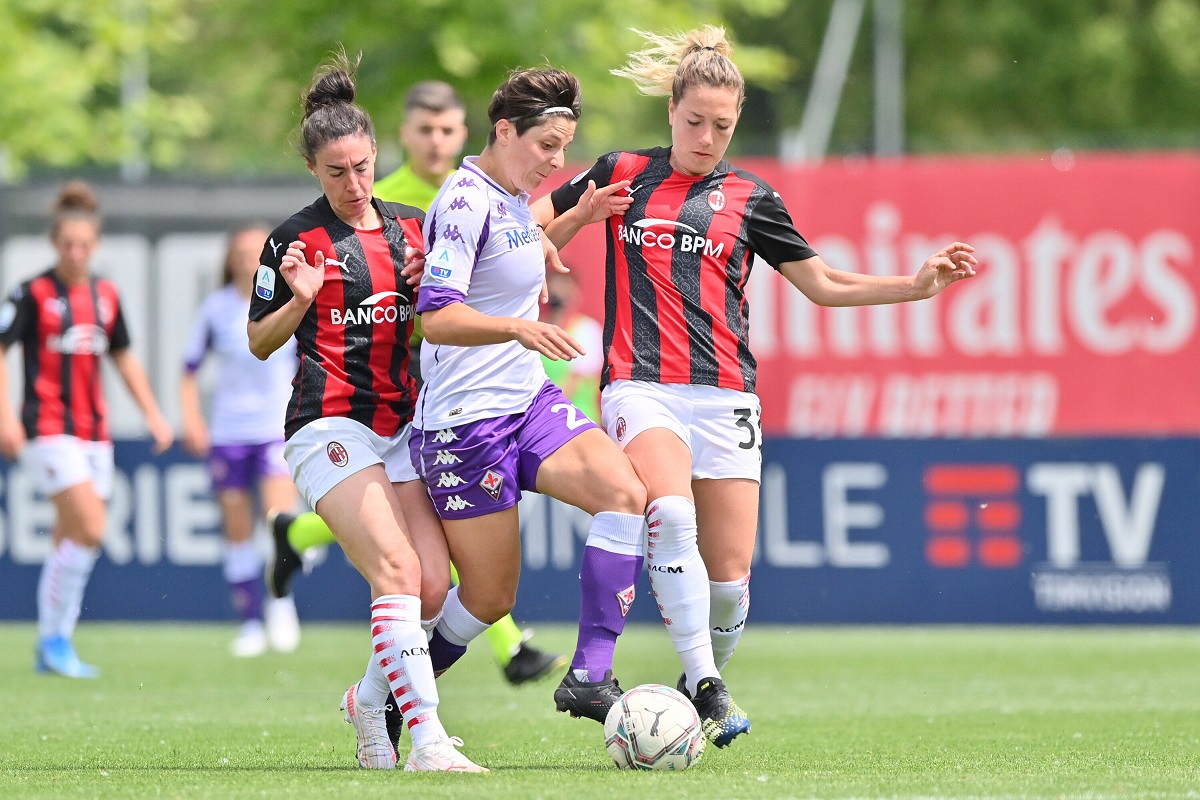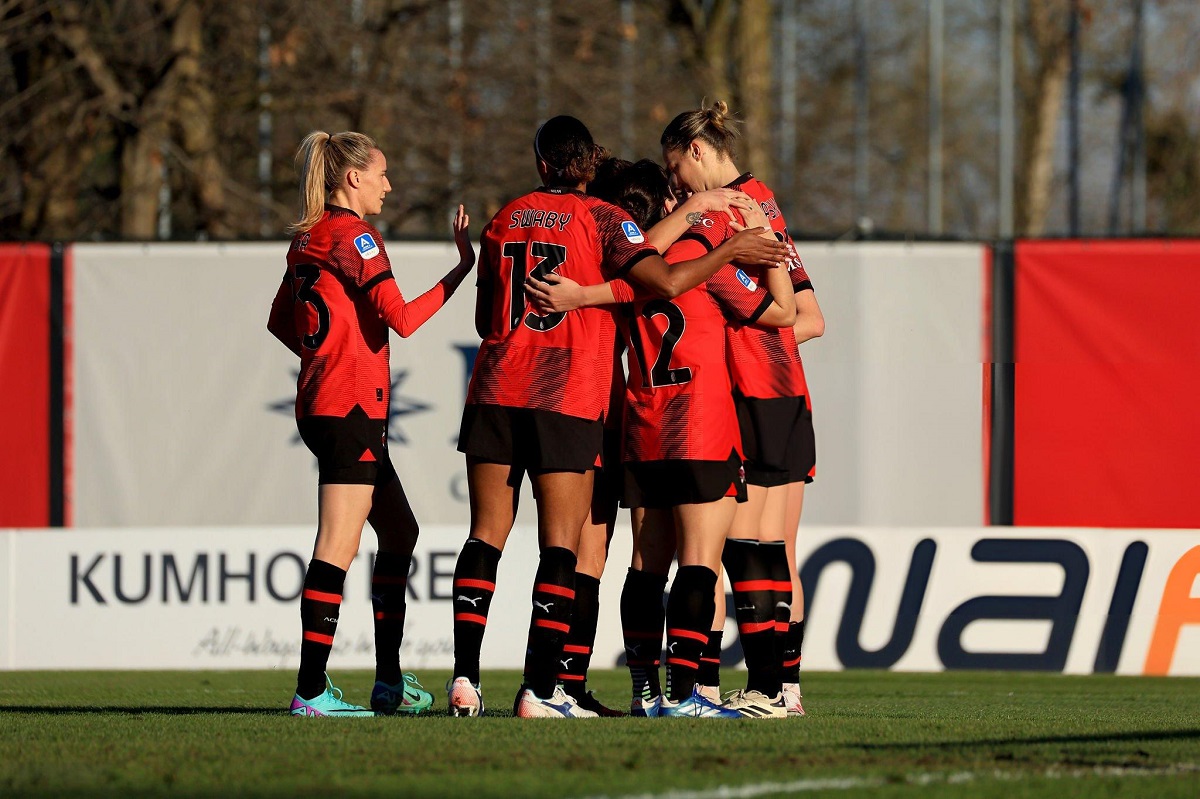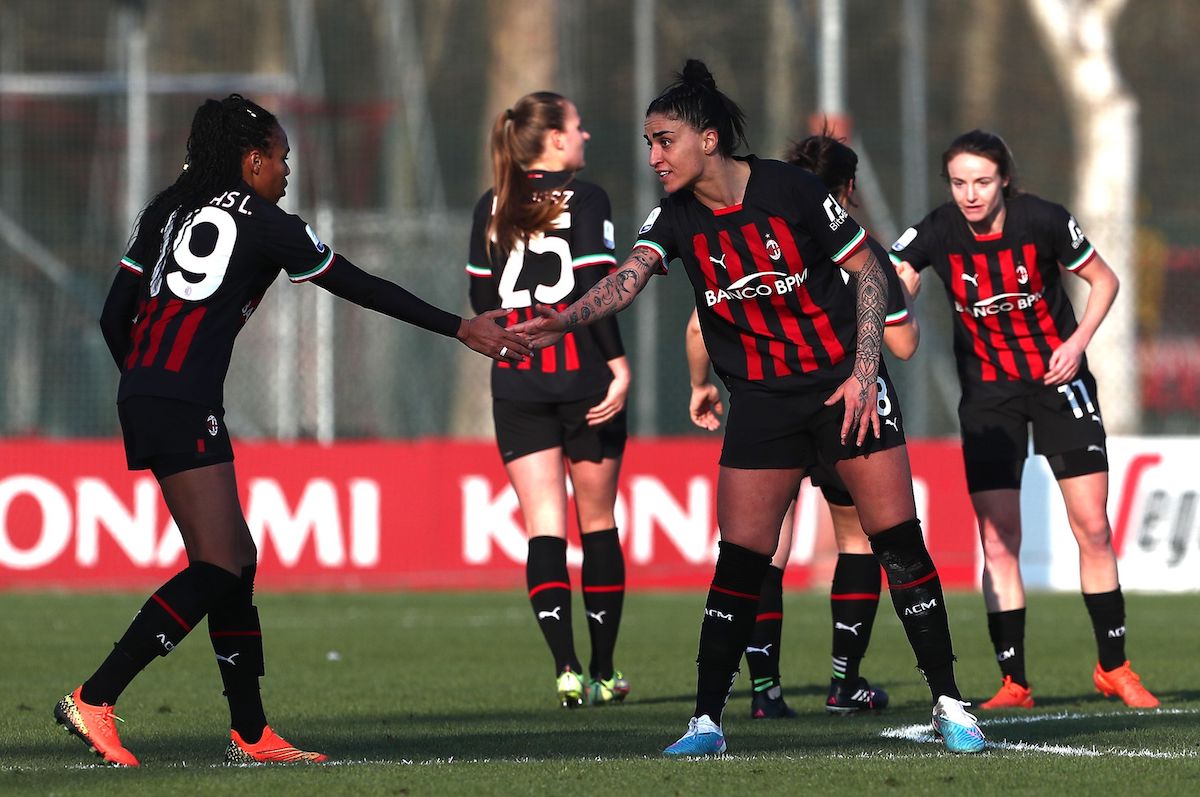The AC Milan Women lost to Fiorentina by a score of 3-1 last Sunday. The loss was a slight setback to the Milan Women’s aspirations of qualifying for next season’s Champions League.
As a result, they have been put in a tight spot for qualification. Milan need to draw or win against Sassuolo and win their last match against Hellas Verona to secure passage to next season’s tournament.
Before then, let’s take a look at what went wrong for Milan during their last match.
The Formations
AC Milan’s Lineup: Korenčiová (14′ Piazza); Vitale, Agard, Fusetti; Bergamaschi, Vero, Jane (78′ Spinelli), Grimshaw (78′ Hasegawa), Tucceri Cimini (56′ Salvatori Rinaldi); Dowie (15′ Piazza), Giacinti
The one thing that stands out about Milan is how they changed their formations several times during this game. The team started in their usual 3-5-2, then switched to a 4-4-1 and then a 4-3-2 to try to see out the match.

The change in formations was in response to Mária Korenčiová receiving a red card and the team going down to ten players. The switch to a 4-3-2, in particular, was done so that Milan could have five players in the central areas which they would then use to create numerical advantages against their opponents during the run of play.
The switch to that formation was also done to force their opponents to play out wide and to limit their ability to build any kind of possession play centrally. The goal was to force the Viola to play on the wings and to use the fullbacks to press and slow down their opponents.
Unfortunately for Milan, things didn’t go as planned, as evident by the two goals scored by Fiorentina’s Baldi (49′) and Vigilucci (82′).
Fiorentina, on the other hand, lined up in a 4-3-3 and then switched to a 4-3-1-2 to close out the game.
Fiorentina’s Lineup: Schroffenegger; Thøgersen, Quinn, Tortelli, Zanoli (70′ Adami); Vigilucci, Breitner, Neto; Monnecchi (75′ Clelland), Sabatino, Baldi (61′ Middag)

The goal of their 4-3-3 was to use their fullbacks and wingers on both sides of the field to open possession and attempt to stretch their opponent’s defensive shape. Fiorentina were able to achieve this during the first half, evident by their attackers pulling Milan’s defenders out of position, which allowed Daniela Sabatino to score the game’s first goal in the eighth minute.
Their goal of switching to the 4-3-1-2 diamond shape was largely similar to Milan’s only, the Viola were better able to implement their plan due to having a one-player advantage.
The Match Itself
The game started with Milan on the front foot as Vero Boquete’s shot bounced off the crossbar at the second minute. Sadly, Milan failed to maintain the momentum. Six minutes later, Fiorentina responded through a goal from the former Milan captain, Daniela Sabatino.
Things only went downhill for the Rossonere from there. Goalkeeper Mária Korenčiová was sent off at the 14th minute for blocking Monnecchi, who was left unmarked by the defense, thus forcing Korenčiová to come out of her box.
The red card was questionable, as it seemed to be a very narrow application of the rule about the denial of a goal-scoring opportunity. What is not up for debate, however, is how Mária’s departure left Milan in a bind, both for this game and the next one. Mária Korenčiová will now miss the match against Sassuolo.
Due to red card, Ganz was forced to replace her with backup keeper Alessia Piazza. He then took Natasha Dowie out of the match to keep the defence and midfield balanced in a 3-5-1 formation. The Viola took advantage of having an extra player on the pitch and threatened Milan’s goal often. Overall, they had 36 shots this game, with eleven of them on target.
The Viola were more organized, especially at the back, as their build-up was concentrated in the centre and was initiated by their centre-backs. This also helped create intensity and up the tempo of their midfield. Their midfield trio of Neto, Breitner, and Vigliucci was solid and benefited from the strong link between defence and attack. As a result, they delivered the ball smoothly between the lines and controlled the majority of possession. Fiorentina had the ball for 62% of the match and thus controlled the game.
Their centre-backs also deserve credit for making the build-up look smooth as they worked to move the ball up front. The game was concentrated in the middle and the battles in the middle of the park were won by Viola’s players. Most of the one-on-one battles were won by their players as well. This is the benefit of having a numerical advantage as they were able to play with one more player than Milan. At times, Fiorentina would switch to a 4-3-1-2 formation, and used it to close the gap between their midfield and defence as they worked in tandem to prevent Milan from getting between the lines.
The fact that some of the Rossonere’s midfield players were having an off day didn’t help either. In particular, Refiloe Jane seemed to be off and did not play like her normal self. What could have helped stabilize Milan’s midfield was the inclusion of the technically gifted Yui Hasegawa. However, she did not play from the start for whatever reason. Instead, Christy Grimshaw was deployed and her technical limitations were exposed during this match.
She is not the sole factor behind the loss nor should she be blamed for everything that happened. However, the decision to field her instead of a more technically gifted player was truly quite baffling.
Fielding limited players and being down to ten led Milan to struggle to find any sort of control during the game. In particular, the majority of the Rossonere’s passes to the final third were not accurate, especially during the first-half of the match. This then prevented the team from creating any truly dangerous chances.
And even when Milan did fire off a few shots, they were not enough to trouble the Viola’s Katja Schroffenegger. At the 45th minute, Valentina Giacinti fired off a lob at the Viola’s goal as Schroffenegger was thought to be going out of goal. However, the shot missed the mark and went wide of the post.
After the halftime interval, Fiorentina doubled their advantage as Sara Baldi got the better of Francesca Vitale and beat Piazza at the near post. The Rossonere, however, would not go down without a fight. At the 61st minute, the ball hit Stephanie Breitner’s arm and Deborah Salvatori Rinaldi was awarded a penalty. Giacinti stepped up and converted from twelve yards. A siege on Fiorentina’s goal followed, with the Rossonere sending several corners into the area.
The goal came about as a mistake from Fiorentina’s midfield, as they turned their backs on Milan’s goal, which slowed down the tempo of the game. It thus gave Salvatori Rinaldi enough time to run into the box and to fire off the shot that landed on Breitner’s arm.
In the 71st minute, Laura Fusetti struck the ball from over 35 yards away from goal, but once again, Schroffenegger spurned the goal away by pushing the ball onto the bar. The Viola were once again, saved by the post three minutes later, as Bergamaschi’s shot bounced off the poles. Coach Ganz then substituted Yui Hasegawa and Giorgia Spinelli into the game in a desperate bid to salve a point. However, it was too little too late, as Vigilucci found the back of the net at the 82nd minute to seal the deal.
And with that, AC Milan lost the match 3-1.
The Stats
Not surprisingly, Milan suffered greatly after going down to ten players. As a result of this disadvantage, Fiorentina were able to control the game, as they had 62% of possession.
Their pass accuracy was also much better than Milan’s as 82% of La Viola’s passes were accurate. Milan only reached 62% pass accuracy, which shows just how much they suffered after Korenčiová’s red card. Had they had an extra player on the field, then they would have been able to successfully string together more passes.
The fact that the Viola pressed the Rossonere intensely also disrupted their rhythm. Fiorentina would press Milan for every 7.4 actions, which meant that they pressed them high and pressed them often.

And though Milan had more offensive actions, they were hampered by only having ten players. The fact that only 12 out of 42 of the Rossonere’s attacks would attest to this. Fiorentina also hit Milan on the counterattack as they, like Roma and Juve before them, realized that Milan are slow in transition and that their defenders would not be able to deal with La Viola’s speed.
The fact that the Viola launched six counterattacks while Milan only had two shows just how limited the latter’s attacks were during this match.

Milan also had 16 shots while La Viola had 13, and the former also had seven corners. Had Milan not gone down to ten, they probably could have been successful with those chances and could have scored more goals.

In the end, it was a rather lopsided affair and Fiorentina were the undisputed beneficiaries of it.
Coach Ganz Fails the Test
If we were to hand out report cards here, then coach Maurizio Ganz would get the lowest grade.
Once again, Ganz’s limits were exposed during this match. The technician’s decision to start the technically limited Christy Grimshaw over the talented Yui Hasegawa is one in yet a series of questionable decisions from the coach.
Furthermore, Ganz rarely uses his bench players. He either doesn’t use them, or substitutes them into the late stages of the match, where they don’t have much time to make an impact. This is a debatable practice that should also be put under scrutiny.
One example of this is the previously mentioned Yui, who was substituted late into the match, at the 78th minute. She, along with Giorgia Spinelli, were both late subs who came on too late to make a real impact for Milan. And yet, when they were substituted into the match, they changed the composure of the game, as Milan played better when they were on the field.
For example, when Hasegawa was substituted into the game, she made four crosses in under twelve minutes. The fact that she was able to make those crosses in such a short amount of time shows you just how much of an impact she can have on the game. One could only imagine what would have happened if she was fielded from the start.

We may never know the reasons why they were not fielded from the beginning of the game.
Ganz seems to be tactically limited and games like this one expose his limitations. Whatever the case may be, he’s going to have to pull a miracle out of his hat against Sassuolo and win the match to secure Champions League qualification.
All one can hope for now is that he actually gets it together and that Milan will win this match.
Conclusion
This was a tough match for Milan. It seems like everything went wrong for the team, from the questionable selection of players to the officiating, to their inability to convert their chances. Milan made several mistakes during this match and will have to learn from them.
One of the lessons learned during this game was that it’s best to field your best players and not bench them for more technically limited players.
If there’s any bright spot for Milan, it came through the many chances they created but did not convert, Giacinti’s goal, and realizing just how important Hasegawa and Spinelli are to the team. The team will need to build off their strengths and rally around whoever their goalkeeper will be during the next game.
The Rossonere need to realize this and get it together soon, as they have a tough test against Sassuolo next. Sassuolo are their direct rivals for Europe and if they lose the match, then it puts their chances of qualifying for next season’s Champions League at great risk.
Up Next
As was mentioned before, AC Milan will play Sassuolo this Saturday at 12:30 CET (3:30 am PST / 6:30 am EST). The match is crucial, as Milan must either tie or win this match to keep their dreams of Champions League qualification alive.
A lead-up to the match, along with how to watch it, will be posted soon.
READ MORE: ‘All roads lead to Dusan Vlahovic’ for Milan – the situation analysed as the Rossoneri wait




